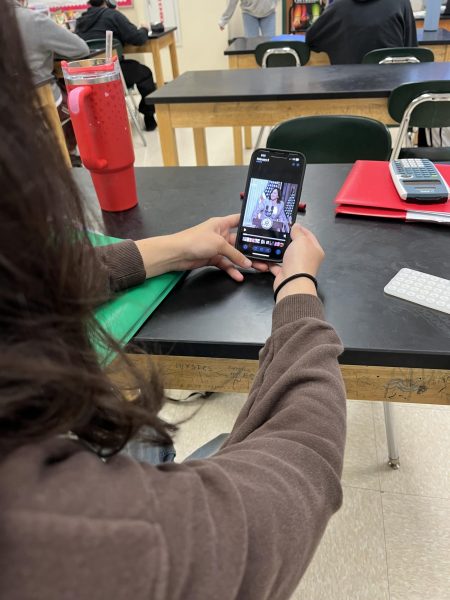Emoji étiquette: Who can safely use them?
As teenagers of the 21st century, we have grown up surrounded by technology. From the original mp3 player to the iPhone 6, there’s always been some new gadget. Twenty years ago texting was unheard of. Now it has become a casual part of our everyday life. Constant communication is essential in this world we live in.
Emojis are an essential aspect of the texting lexicon. These small icons are used to convey emotions, ideas, etc. in electronic communication. There are over 1,620 emojis in the most recent iOS 9.1 update. They depict images of animals, food, smiling faces, angry faces, multiple people, hand gestures, and even flags just to name a few. Used by both men and women alike, people see these emojis and automatically associate them with feelings, thoughts, or ideas. It has been disputed whether or not these emojis are acceptable in everyday conversation.
This is especially true in modern day relationships (particularly teenage relationships). Small talk has evolved into sitting at home texting your crush. We get to know each other now not actually face to face, but through the use of these “very meaningful” symbols. Girls can usually get away with using emojis because they are seen to be much more expressive than guys in general. It has almost become a societal expectation that girls use emojis.
However, emoji usage doesn’t have quite the same social acceptance for guys as for girls.
“If guys use heart emojis, it can be uncomfortable sometimes,” said one anonymous senior girl. “Use of the winky face is pretty hard to judge.” A lot of people agreed that awkward use of emojis or too many emojis can be “a force” for both guys and girls.
Many people also brought up that when guys use the tongue emoji with the three water droplets it can be very awkward. One senior girl who wishes to remain anonymous said, “Keep that away from me!” Heart emojis and other suggestive emojis can be used in casual conversation between friends whether they’re using the emojis seriously or jokingly. It all depends on the context of the emoji use.
In order to keep up with our virtual profiles, today’s society has become accustomed to checking for text messages and social media notifications several times a day. Based on a study at the Pew Research Center, 46% of smartphone users say their phone is something they “couldn’t live without.”
By texting with emojis, words typically aren’t as necessary to a text message as they used to be. Being the busy Americans that we are, using emojis saves a lot more time than typing out an entire message. According to AdWeek.com, 92% of the online population admits to using emojis. This survey also states that those who more frequently use emojis think that emojis can convey a deeper meaning than just texting words can.
“I usually use emojis to help get my message across,” said senior Samantha Medeiros. The main reason emojis were created was to help eliminate misinterpretation of text messages. “I can’t wait to see you tonight!” with a smiling emoji could mean someone is excited to see you, whereas that same text with a winking emoji could be a little more suggestive.
In general, it really all depends on the emoji and its context.
“I use emojis all the time!” said enthusiastic senior Shawn DaSilva. Emojis can make conversations flow a lot more easily. “If I’m talking to a guy, I use less emojis, but if I’m flirting with a girl I use more emojis.” Most students agreed that they will use more emojis when talking to a person they have feelings for rather than just their friends.
“When guys use blushing emojis it shows that they’re interested in whoever they’re texting,” said one senior girl who wishes to remain anonymous. “I think it’s fine when guys use them.” Some people use a lot of emojis, some don’t. Based on the conversation, it’s typically pretty easy to tell whether or not the emoji is suggesting more than just the smirk and raised eyebrow it depicts.
“If guys use emojis, it shows that they’re an emotional, expressive person,” said senior Hana Chouinard. “It shows that they’re into the conversation.” Most of the time, the emojis are just happy, smiling, or laughing faces. Using emojis is innocent and helpful to get the point across.
Even beyond just teenagers, emoji use is prevalent with adults, too. It can be a bit humorous to think about our parents using emojis, but it certainly isn’t uncommon in the adult world.
“I do use emojis,” said Social Studies Lead Teacher Jeff Reed, “but I always use them with actual words.” Mr. Reed isn’t the only teacher to use emojis either, “There was a teacher group chat the other day where everyone was talking and using a bunch of different emojis, so I decided to drop the watermelon emoji and it confused everyone.”
We tend to assume that just because someone isn’t from our Millenial generation that they don’t know how to operate a smartphone beyond simple texting and calling. However, Adweek.com stated that 62.3% of people over the age of 35 use emojis frequently.
I’ve even seen some of my friends texting their parents using emojis. These tiny little pictures can be helpful to get the conversation across and allow everything to flow more easily. Emojis create a casual vibe while texting and typically allow for a more friendly texting environment altogether.
Adult or teen, guy or girl emoji use is definitely acceptable. There are always going to be people who may read a little too deep into the conversation or the emoji expression. Just keep it short, sweet, and to the point.








Jack D'Atri • Apr 4, 2016 at 7:16 pm
Did you know the “Smiling piling of poop” emoji was originally meant to be soft-serve chocolate ice cream? However, everyone mistook it for a smiling pile of poop, so Apple just went along with it. It’s my brother’s favorite emoji.